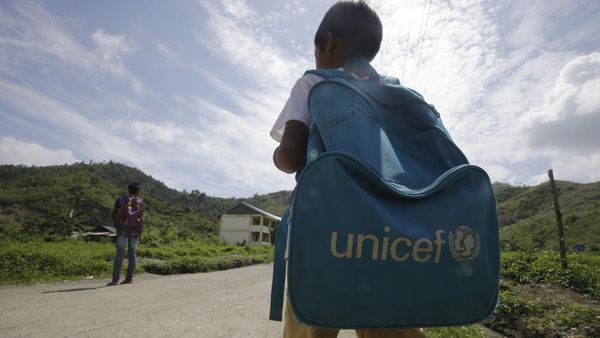The U.S. Supreme Court's decision to reverse decades of legal precedent by overturning Roe v. Wade — the 1973 ruling asserting constitutional protections for a woman's right to choose whether to have an abortion — triggered laws in multiple states either outright banning abortions altogether, or severely restricting the ability to access them. In most cases, these laws only allow abortions in cases where the procedure will prevent serious injury or death. Those exceptions aren't nearly as reassuring as some may believe them to be.
The maternal mortality rate in the United States is abysmal, especially for Black women who die at nearly three times the rate during childbirth as white women, according to the Centers for Disease Control and Prevention. Among developed countries, the U.S. ranks among the worst in terms of maternal mortality, according to The Commonwealth Fund, a private foundation funding research and grants around health care issues and policy. Maternal deaths have been increasing here since 2000, with two-thirds of those deaths reported as preventable, and this is partly attributable to low numbers of midwives and obstetricians/gynecologists, access to postpartum care, an absence of guaranteed paid parental leave, and systemic racism.
"We have been working to understand the Supreme Court ruling and its impact on every single state across the country. We know that this has created, and will continue to create, immense confusion and issues with patients being able to get the best care for them," said Dr. Jenni Villavicencio, a board-certified obstetrician/gynecologist who serves as the lead for equity transformation at the American College of Obstetricians and Gynecologists, leading their anti-racism, diversity, and equity and inclusion work. "I am especially focused on the impact that this ruling is going to have on the most marginalized, historically and currently, in our country. That includes Black, Indigenous, Hispanic, and other people of color, as well as people who are poor, living in rural or remote areas. We know that they are going to be impacted the most by these laws and they are already impacted by racism and the way that it manifests itself in the healthcare system." She took some time to talk about what it looks like, from a medical perspective, to make a life-saving decision during pregnancy; whether adoption is a sufficient alternative to abortion; and the very real risks of patients being forced to carry pregnancies to term without the option of abortion as part of their overall care. (This interview has been edited for length and clarity. )
Q: A number of the trigger laws that are going into effect will only allow abortions in the case that the life of the pregnant person is at risk, but what that means seems unclear. What's your understanding of how this would work in practice? How do you determine when a pregnant person's life is at risk to the extent that an abortion could be performed legally? What factors go into making that kind of decision?
A:I can tell you that many people are, in some ways, breathing a sigh of relief with these exceptions. "Oh, well, at least if someone's life is at risk, the doctor can intervene." Unfortunately, it's not nearly as clear-cut as that because these laws are being written by non-scientists, and certainly not experts in medicine. They are not reflective of the way that medicine is actually practiced.
We know that "life-threatening" is certainly a term that is used, and when someone's life is at risk, that can mean many, many different things along a spectrum. There's no line that says, "OK, now is the moment that you are dying." That's not a clear moment in in time. It is a slow, sometimes fast, fall down a clinical hill. What we are seeing, and what we're deeply concerned about, is instead of physicians being able to treat someone at the moment that they make a diagnosis and know what the right treatment is, we will have to wait for the person to get sicker and sicker — sick enough for the physician, as well as the hospital, to be willing to risk the consequences of the laws. Sometimes, that means that people will get so far down that road of becoming sick that you may not be able to come back. The reason why a principle in medicine is to "treat as quickly as possible" is because we don't want people to get that sick. Unfortunately, these medical exceptions are not as clear as people would hope that they are. They really are putting the burden on the physician to be able to decide whether or not they're willing to face civil, professional or even criminal penalties for doing the best things for our patients. That sort of interference in the patient-physician relationship is cruel and dangerous.
Q:As many anti-abortion organizations celebrate this ruling, some of their representatives have talked about a focus on caring for pregnant people that highlights adoption as a response to an unintended or unwanted pregnancy. From your perspective, is adoption a sufficient alternative?
A:Before I answer that, I want to mention that while the way that we're hearing about this decision is that it's being portrayed as there are winners who are happy about this and then losers who are not happy about this, what I can tell you is that the reality is that every single American in this country loses and is more at risk because of this decision. I do abortions for everybody: I do abortions for people who are against abortion, I do abortions for people who are pro-abortion, I do abortions for people who don't know how they feel about abortion. The reason for that is that when a family knows that abortion is the right decision for them, the ideology and the politics go out the window. They know that this is the right medical decision for them to make, so this is not a win-or-lose situation for some people, it's a lose situation for everyone.
We often hear adoption being offered up as a potential alternative to abortion. As someone who takes care of pregnant people — I deliver babies, I do prenatal care, and I also perform abortion care — what I understand is that adoption is not an alternative to abortion, it is an alternative to parenting. In order to place an infant or a newborn up for adoption, you have to go through what, for many people, is life-threatening pregnancy. It requires 10 months of ongoing and nearly weekly medical care, sometimes physical ailments that mean that you can't work, and you may not be able to take care of your children as well as you have before. There are plenty of people in this country who are reading this who know exactly what I'm talking about. Pregnancy is not a walk in the park for most people, so adoption certainly may be an option for some who don't want to parent, but it's not an alternative for people who do not want to, or cannot, be pregnant.
Q:The United States reportedly has one of the highest maternal mortality rates of any industrialized country, with that rate rising in 2020 for Black and Latina women. Can you talk about some of the complexities and risks of pregnancy that should be considered in these discussions about abortion as a reproductive health choice? The kinds of illnesses and diagnoses you've seen as a result of pregnancy and how risky it is, in practice?
A:There's no way to talk about abortion bans and restrictions without talking about the abysmal and, frankly, embarrassing maternal mortality rates in this country, particularly for Black, Indigenous and Hispanic women. We are essentially forcing people to remain pregnant. Many of these abortion-ban states are forcing pregnancy on people in an era where maternal mortality is rising. People who are pregnant are more likely to die in pregnancy now than our parents were, than our mothers were. We are also not improving our social safety nets. We're not improving the ability of parents to work and take care of their children. We don't have great health coverage in this country, we certainly do not have any sort of paid parental leave, and we also have terrible infant and child mortality rates in this country. So, we cannot talk about abortion bans without putting it against the backdrop of the vital sign that we are really failing in this country, which is maternal and child health.
In terms of some of the specific conditions that come up, we know that because of racism and other social determinants of health, that people of color and people who are poor and living in rural or remote areas, are more likely to have chronic health conditions, which then can be exacerbated by pregnancy. Pregnancy is natural, but it's also a health condition, which means that it has the potential to have serious complications for almost every single organ in the body. It can result in life-threatening high blood pressure, life-threatening blood clots, worsening of heart, lung, and kidney disease. All of those things are possible and not uncommon, and it's the reason why I, as an obstetrician/gynecologist, work in conjunction with my partners who are midwives and nurses to make sure that we are keeping pregnant people as healthy as they possibly can be. However, make no mistake about it, pregnancy can be quite dangerous. We certainly know that people die from pregnancy on a regular basis in this country, so forcing anyone to remain pregnant when they don't want to is absolutely an act of cruelty.
Q:In previous interviews, you've mentioned that you were once someone who shared anti-abortion views. What changed your mind? What did that path to your current perspective look like?
A:I was brought up very conservative, very Catholic, and I was an anti-choice activist (or what I used to call a pro-life activist) well into my early 20s. A series of personal and professional experiences, and exposure to what the nuances and complexities of life and medicine are, helped me understand that the black-and-white that I subscribed to — the "all abortions are wrong and life begins at conception" thinking — was not only completely contrary to the reality of the way that science, biology, and life actually work, but I was judging people before I knew them. I was not looking at my patients and saying, "You know what is best for you, and I want to help you safely get to that point."
There was a moment in my training that I realized that all of the values that I'd learned — values of justice and dedication to family and motherhood, medicine and science, independence — that I still deeply held from my childhood, were much better exercised by taking people as they come. By saying, "How is it that I can help you today because I trust you to make the best decision for you and your family." I feel like I am in a much better place, being able to follow my conscience, my morality, and my ethics as a physician, a neighbor, and a fellow human to the people that I take care of. That doesn't mean that abortion is straightforward. Nothing is. All of this, pregnancy and life in general, is extraordinarily complicated. Leaning into that complexity and understanding that some people may still feel complex, or even negative about abortion, and want to support their family members or their own ability to access abortion when it's needed is important. I see patients and people who do that every single day. Sometimes, I have hard days and being able to hold that complexity is incredibly important, and where I really hope that we can get to at some point because black-and-white thinking is only that: it's politics, it's ideology. It is not the reality of the way that people actually live their lives.
Q:In your experience, what are some of the preferred ways to support people who can become pregnant, especially now?
A:I think that there's a lot of confusion right now. There's a lot of panic and concern, which is understandable and probably warranted. I think that the way that doctors can support their patients and other people that they're talking to, is by giving them as accurate information as possible. In the scenarios in which they're not able to give that kind of information because they are restricted by law, then inform patients that they are restricted from giving that information so that patients understand that they're not getting the full complement. I think that anyone who's talking about any of this — abortion, maternal mortality, racism in medicine — anyone in the media or journalism, should really be emphasizing that this is something that impacts everybody, that abortion is incredibly safe, and that these laws are not based in science or in medicine. Making sure that folks have accurate information that is as up to date as possible, and also encouraging people to ask questions and to advocate for themselves, and to be careful about how they're doing that. There's a lot of information about how to protect yourself online with data, so seeking those resources out. It's something that I talk to patients about, as well.
____







